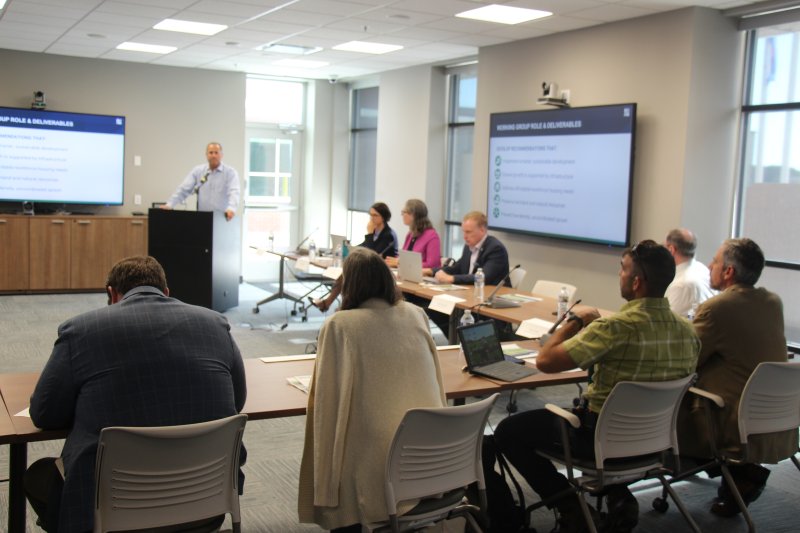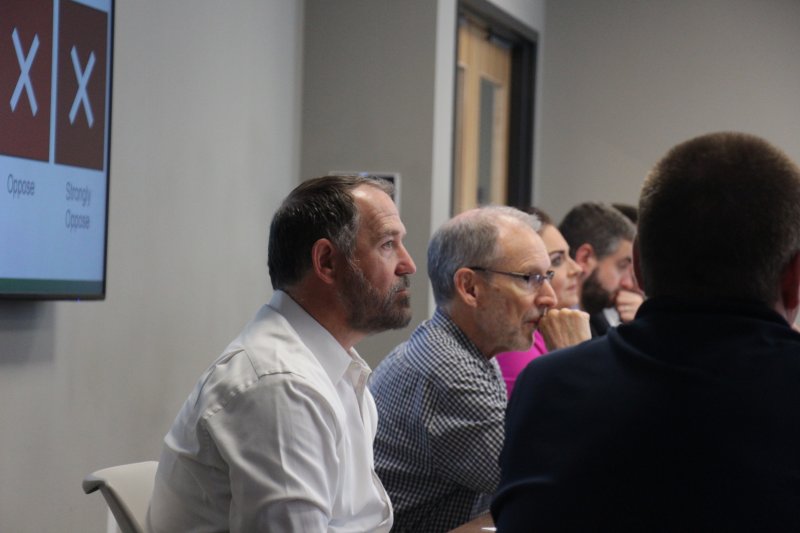Panel agrees on 20 recommendations to redirect Sussex housing growth
An advisory panel backed 20 recommendations Sept. 11 to consolidate growth in Sussex County, encourage more types of housing, and preserve open space and farmland.
During its 10th meeting, the county’s 10-member land-use reform working group voted silently using their cellphones. For each recommendation, they selected from a five-choice scale: strongly support, support, I can live with it, oppose or strongly oppose.
They considered 19 suggestions discussed at the previous meeting and another offered the previous night via email by Mike Riemann, a member who represents the American Council of Engineering Companies.
The latest recommendation involves mixed-use developments in commercial districts. It suggests updating the zoning code by aligning permitted uses, increasing height flexibility, regulating density through building form and modernizing parking standards to encourage shared solutions.
This would “foster vibrant, walkable centers that expand housing options, support local businesses and make efficient use of infrastructure while preserving community character,” according to the description.
Andrew Bing, a consultant coordinating the group’s work, said before the vote that he was initially reluctant to present the recommendation. But several members supported it, and the county and consultant staff agreed the idea had been discussed earlier in the process, he said.
“It was a huge part of the discussion,” said David Edgell, director of the state’s Office of State Planning Coordination, who serves on the working group.
The results of the voting will be forwarded to Sussex County Council for consideration when drafting rules in coming months and the comprehensive land-use plan due by the end of 2028, council President Doug Hudson said after the meeting.
The only negative votes were a single one cast for three recommendations: establish growth and conservation areas; strategic density adjustments; and encourage naturalized landscaping in passive open spaces, focus subdivision design in conservation areas around conservation priorities.
Jay Baxter, a farmer representing the Sussex County Farm Bureau, has said creation of growth zones, a key component of the group’s recommendations, would harm farmers by lowering the value of their land.
“We are picking winners and losers for land,” he said Sept. 11.
“I struggle with some of these boundary lines we are going to be creating, and I think what we had set out to do as a group is to minimize sprawl,” Baxter said. “I think we have done exactly the opposite in creating these growth zones and conservation zones. I can imagine we will consume more farmland and open space because of these designated zones.”
Bing said individual members can raise their concerns with county council when it considers changing rules.
The group also voted to back the recommendations as a whole, and several said that all of the pieces need to be considered together to have the intended effect.
County Administrator Todd Lawson praised the work group, county staff and consultants for their work in crafting the recommendations over five months.
“There was a lot of behind-the-scenes coordination that got us to this point at such a quick clip,” Lawson said. “This was a Herculean effort when we started, and I wasn’t sure how fast or how comprehensive we would be ... and it’s all because of your work and your willingness to roll up your sleeves and deliver the product.”
“I think I’m pretty proud of the recommendations that came out,” Riemann said after the meeting, noting the proposals covered many issues critical to development. “I think they do a good job of addressing the competing priorities and interests."
The rules, if adopted by county council, would help alleviate a housing affordability crisis, he said.
“I think we have a broad concept that’s good to go ahead,” said Jill Hicks, president of the Sussex Preservation Coalition and a working group member.
“I think it’s a miracle that we came up with 20 things we agreed on,” Edgell said.
He said he was encouraged by the working group’s process, and the communication between his agency and county officials in recent months, the first of their kind with Sussex County in his more than 20 years working for the state agency.
The working group was formed because of growing community concerns over booming housing development that has overburdened roads, schools, emergency services, medical providers and the environment.
Three newcomers calling for change defeated incumbents and took a majority on the five-member county council. Hudson, a holdover from the past council, credited them with the recommendations offered Sept. 11.
“We have a comp plan [update] coming up soon, so we need to be meeting on that,” he said. “We need to be prepared. There are going to be changes. The three new council members; I’ve got to give them credit.”
Lawson said a report on the working group’s recommendations will be drafted and placed on the county website at some point. County council will also have to determine how to move ahead with considering proposals.
“They have been following along very closely,” he said. “They are anxious to get to work right away. I think that gives us a signal of how quickly we will turn this around.”
Working group recommendations
The 20 recommendations expected to be presented for votes by the Sussex County Land-Use Reform Working Group are:
- Align future land-use map. As part of the preparation of the next county comprehensive land-use plan scheduled to be completed by the end of 2028, the county should revise the map using the State Strategies for Spending as a guide. The changes should designate boundaries of the growth areas and conservation areas
- Establish growth and conservation areas. There were suggestions for criteria to be used to determine boundaries of growth zones, which kinds of zoning would be allowed in each zone and protections for conservation districts
- Comprehensive rezoning through the county comprehensive plan, enabling housing diversity and affordability
- Establish clear standards for reviewing requests for rezoning, consistent with the comprehensive plan, compatibility with zoning district intent, environmental suitability of the site and proximity to existing or planned supportive infrastructure
- More clearly define “missing middle” housing types that are lacking in the county
- Permit “missing middle” housing in strategic areas, making it easier to build in growth areas the duplexes, triplexes, townhomes, cottage courts, stacked flats and multifamily buildings that would fill housing needs
- Establish bulk and setback standards for “missing middle” housing and adjust height, building length and separate caps in growth areas. Details were proposed in the suggestion
- Strategic density adjustments to promote growth in targeted areas and discourage development in conservation areas. That includes per-acre maximums of one unit in AR-1 zoning districts, four units in GR zoning districts, six units in MR districts and 18 units in HR districts
- Develop strategic density bonus program to create incentives to preserve open space, farmland, natural resources and affordable housing. Sussex County Preservation Program would allow greater density in growth areas in some zoning districts in exchange for a fee that would preserve farmland, forest and high-value natural resources in conservation areas. The Sussex County Purchase Program would allow greater density in some zoning districts in growth areas in exchange for creation of affordable housing
- Amend the county rental program to make it more attractive for developers to include such housing in developments
- Create transportation improvement districts for all growth areas and develop a transportation impact fee for development in conservation areas
- Complete adoption of the drafted master plan zoning ordinance for large-scale development
- Forest preservation
- Encourage naturalized landscaping in passive open space
- Focus subdivision design around conservation priorities
- Support working farms through permitted agricultural support uses outside growth areas, such as allowing processing facilities and equipment repair businesses
- Explore a transfer of Development Rights Program. Homebuilders would buy development rights in conservation areas, which would allow them to build in growth areas
- Improve clarity and consistency of Subdivision Code Section 99-9(C) standard
- Prioritize hearing scheduling for projects that advance county land-use goals
- Modernize code to support mixed use by making such development a predictable use in a commercial district.
Kevin Conlon came to the Cape Gazette with nearly 40 years of newspaper experience since graduating from St. Bonaventure University in New York with a bachelor's degree in mass communication. He reports on Sussex County government and other assignments as needed.
His career spans working as a reporter and editor at daily newspapers in upstate New York, including The Daily Gazette in Schenectady. He comes to the Cape Gazette from the Cortland Standard, where he was an editor for more than 25 years, and in recent years also contributed as a columnist and opinion page writer. He and his staff won regional and state writing awards.
Conlon was relocating to Lewes when he came across an advertisement for a reporter job at the Cape Gazette, and the decision to pursue it paid off. His new position gives him an opportunity to stay in a career that he loves, covering local news for an independently owned newspaper.
Conlon is the father of seven children and grandfather to two young boys. In his spare time, he trains for and competes in triathlons and other races. Now settling into the Cape Region, he is searching out hilly trails and roads with wide shoulders. He is a fan of St. Bonaventure sports, especially rugby and basketball, as well as following the Mets, Steelers and Celtics.























































